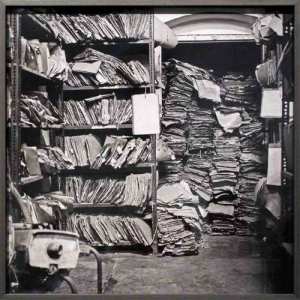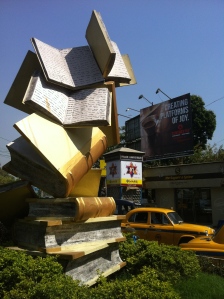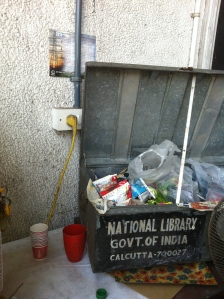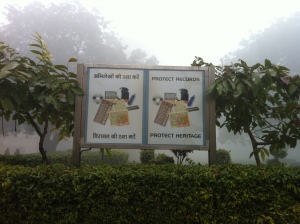Archiving in India
Last July, for the SAALG 91st conference, I presented a paper about the collaborative ETIC project with a particular focus on conducting archival research in Calcutta. Coming to the end of my three month INTACH funded research trip provides another opportunity to reflect on the underused archives and historical resources in Calcutta and Delhi.
As funding opportunities for research and collaboration in India increase, navigational tips for these bountiful resources are necessary. Patience is most profoundly a virtue when embarking on research in this area. Scholars have been spoilt by the digitalised and swift experiences offered by the British Library, National Archives in Kew and Cambridge Centre for South Asian Studies to name but a few. Whilst digitalisation initiatives are well in progress and online catalogues are becoming more widely available these are not yet the standard.
Scholars will face an elongated process, in places with fewer plug sockets, more Bic biros, lesser pencils, more paper work, lesser snake weights, more of the unweighted variety but this, along with dodging dust and wilder life than those sat at the lit leather desk spaces of the Asian African Studies Reading Room, makes working with the resources excessively rewarding.
As historians will no doubt recognise, archival forays can be oscillating, isolating, frustrating and ‘feverish’ experiences. Frenzied index searches for access to the entrails of bureaucracy are our preserve. Navigating new domains are facilitated by custodians of the stacks who hold the key to something urgent, something pressing that never before was a part of our mind or scholarly matter.
Receiving that record from that date and that day will unfurl the answers to questions unasked. Lists of documents from which to deduce something become part of the historians archival accoutrements. These references replicate and anxiety ensues. As Steedman observes:
‘Your anxiety is that you will not finish, that there will be something left unread, unnoted, untranscribed. You are not anxious about the Great Unfinished, knowledge of which is the very condition of your being there in the first place, and of the grubby trade you set out in, years ago.
You know perfectly well that despite the infinite heaps of things they recorded, the notes and traces that these people left behind, it is in fact, practically nothing at all. There is the great, brown, slow-moving strandless river of Everything, and then there is its tiny flotsam that has ended up in the record office you are working in.’

File Room, 2011 Dayanita Singh
http://www.dayanitasingh.com
Calcutta’s reams of East Indian bound leather records and tied files, as per Dayanita Singh’s work, red rotting, furnish state voices. The Offy Sec to that department which was formerly known as this which was listed as that which was subdivided, which was substandard so reformed and reinstated as this for that time under this Chief Magistrate who instigated that Committee who formed, for part of this year, which then deteriorated, which was then reinstated and then reformed under this Chairman and that Right Honorable Gentleman who was pleased to read this report and that suggestion of regulation which then amounted to a series of enactments and litigation.
In the research rooms of the National Archives of India, eyes dart and eyes strain as the East India Company crested pages flutter from references to correspondences from that month ultimo or this month instant. Behind mahogany book stands faces furrow into the furrows of flies and book worms before. Researchers intake the marginalia which alludes to other Company conversations, the letter number 1203 from that Superintendent to that Lieutenant, which was attached to that memo and forwarded as per request to that Assistant to that Master who read it and urged that this concern would be most effectually repressed by this measure at this cost of the Company’s Rupees, Annas and Pies for the system would be ‘highly instrumental’ and ‘effect considerable increase in efficiency’.
In the vestiges of the West Bengal State Archives the tip tap tapping of various velocities of typing upon pads of miniature laptops: standard researcher issue, along with the spin of fans clipping mosquito wings and other airborne things, maintains the historian’s synaptic functioning. Cough, splutter, achoo, sigh, whisper, mutterings of indignation, yelps of celebration are the soundings of this performative work in which hours become a futile means of measurement.
This over-excitement of the brain is met with an under-excitement of the body. Weighty legs and generously padded posteriors develop from scholarly stagnation. For, as 18th century medical knowledge professed, ’inactivity is the great bane of literary men….It is plain that…men’s minds are too much engaged and their bodies too little’.
Whilst a current solution, remedy, pill or powder remains yet to be packaged and promoted, I hope that the information herein will diminish archival anxieties which are all the more pronounced when first operating in India’s archives.
Although documentation requirements will differ from archive to archive it is prudent to take
* passport
* photocopies of passport
* letter of recommendation from your institution
* letter of authorisation from your embassy
* two passport photos
* address of residence in India
Added accompaniments might include
* Ors rehydration salts
* Face mask
The West Bengal State Archives Historical Section situated off College Street near MG Road metro, is an enclave of Government records from 1758 to 1900. Their other holdings are split between two other sites. Records post 1900 are held at Writer’s Buildings, whilst items from the Intelligence Branch, Public Works Department and Chancellor Secretariat records are located at The New Functional Building on Shakespeare Sarani.
The research room of the Historical Section, on the second floor of the building is diligently managed by Dr Sarmistha De and Bidisha Chakraborty. Their publication, ‘Calcutta in the Nineteenth Century’ (2014) provides a good entry point into the material as does the volume they have co-edited, ‘Select Documents on Calcutta 1800-1900’ published by the Directorate of State Archives, Higher Education Department, Government of West Bengal (2011).
For access to these archives visit the website and download an application form. Present this with your passport and a photocopy, a letter from your embassy and two passport photos. The research room opens from Monday to Friday 11am-5pm, with requests for material open from 12pm-4pm.
For Transport: Metro to MG Road or Central, then a short walk
For Fluids: Bring your own water, drinking permitted in the research room
For Sustenance: Bring a tiffin or survive on Rs5 packets of peanuts and dried chickpeas
The National Library situated in Alipur South of the historically important Maidan site in Calcutta, has a extensive selection of microfilm newspapers and rare books. The Library has a broad collection of items pertaining to India across a multitude of languages. In accordance with the Delivery of Books and Newspapers Act 1954, all Indian publishers publishing in any language across the country, are legally bound to deposit one copy of the publication to the Library.
The library was established in March 1836 as Calcutta Public Library. After merging with the Official Imperial Library, it was opened to the public on the 30 January 1903 as the Imperial Library by John Macfarlane, the then Assistant Librarian of the British Museum. Post Independence, the library was afforded special status in the Constitution as an institution of national importance becoming The National Library in 1948.
For access to this collection a Reading Room card is required. Apply inside the main building with relevant documentation. For the use of laptops and cameras, written permission is required. The Library Information Officer, situated on the ground floor, can provide assistance. The main reading room is open from Monday to Friday 9am-8pm and on Saturdays and Sundays from 9.30am-6pm. Requisitions can be made during the week from 9.30am-6pm.
For Transport: Metro to Jatin Das Park or Kalighat, then a short auto rickshaw. Alternatively numerous buses stop outside the main entrance.
For Fluids: Purified water machine on second floor, drinking is permitted in the research room.
For Sustenance: Library canteen on-site. Coffee and snack stall on ground floor.
On Alipore Road there is a South Indian restaurant, Garden Cafe serving more substantial meals.
The Centre for Studies in Social Sciences was founded in February 1973. The campus at Baishnabghata Patuli Township houses the Jadunath Sarkar Resource Centre for Historical Research, a depository of vernacular language materials relating to the social and colonial history of Bengal and Eastern India. It is necessary to contact the Centre in advance.
The Centre also runs an MPhil and PhD programme as well as hosting academic events throughout the year including conferences, seminars and workshops such as the recent ‘Maritime Networks and the Construction of Trans-National Spaces: Comparative Approaches and Connected Histories’ held in December 2014.
For Transport: Metro to Kavi Subhash, then a short walk
For Fluids: Purified water machine on second floor, drinking is permitted in the research room
For Sustenance: Canteen on-site with open air seating
The National Archives of India were inaugurated post Independence having previously been known as Imperial Records Department established in March 1891. The collection comprises non-current Government of India records and has additional cartographic records, microfilms, private papers and a library with recent and rare books, reports, gazettes and journals.
For permission to use the resources you will need to consult the Archive Director who occupies an office in the ground floor research room. A passport and copy with a letter from your Embassy and passport photos are required. The research room is open from 9.30am to 8pm Monday – Friday. For entry to the research room on Saturday it is necessary to obtain a special admission pass from the requisition desk.
For Transport: Metro to Janpath or Central Secretariat, then short walk
For Fluids: Purified water machine on ground floor in the research room, drinking is not permitted in the research room
For Sustenance: Canteen on-site. Coffee and snack stall on first floor.
There is an incessantly busy dhaba near the side gate serving chai, puri, rice and dahl throughout the day.
References:
Eric Prenowitz, trans. (1996) Jacques Derrida, Archive Fever: A Freudian Impression Chicago
Steedman, C. (2001) Something She Called a Fever: Michelet, Derrida, and Dust, The American Historical Review, Vol 106, No.4 October pp.1159-1180
West Bengal State Archives, Judicial Criminal Record, 6th Dec 1836, No 5
Graham on Indigestion in First Annual Report of the Society for Promoting Manual Labor in Literary Institutions: Including the Report of Their General Agent, Theodore D. Weld, January 28, 1833 New York: S.W Benedict & Company p24







